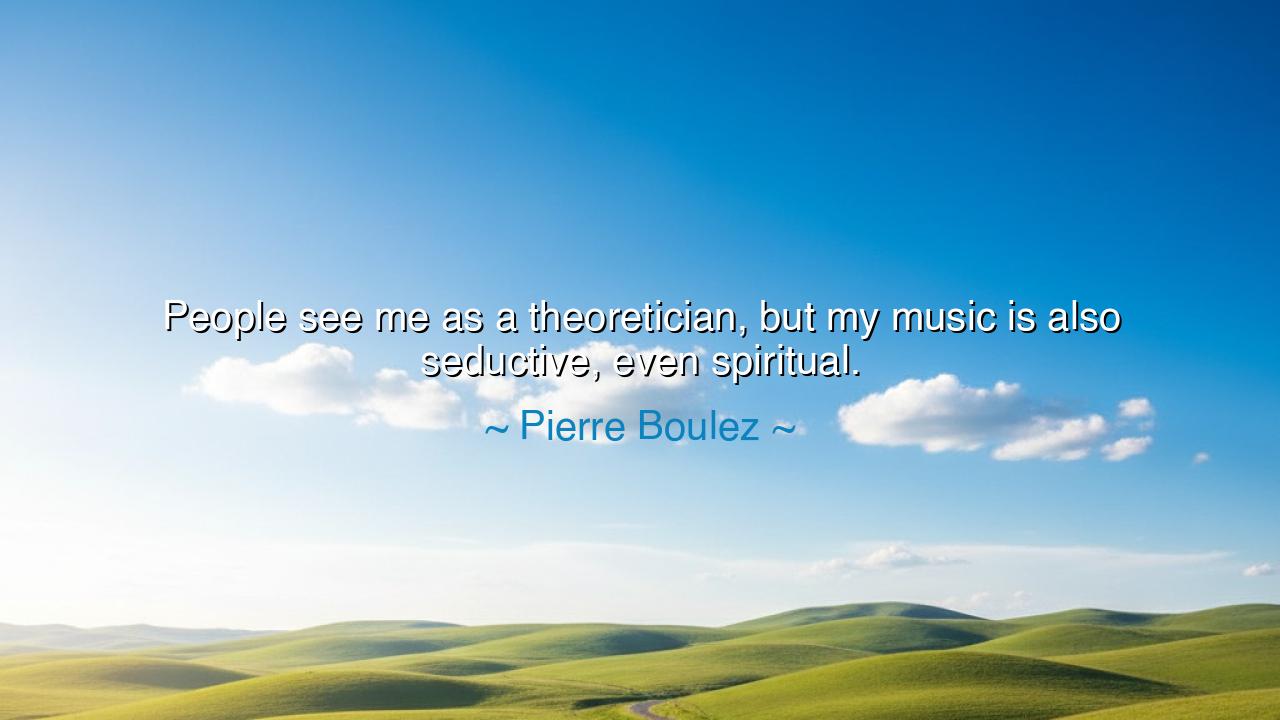
People see me as a theoretician, but my music is also seductive






Hear the words of Pierre Boulez, master of sound and mind, who declared: “People see me as a theoretician, but my music is also seductive, even spiritual.” In this statement lies the eternal struggle between intellect and passion, between structure and spirit. Boulez, often regarded as a titan of theory and innovation, reminds us that art is not only an edifice of reason, but also a flame that kindles the heart and a whisper that awakens the soul.
To be called a theoretician is to be seen as a man of calculation, a builder of systems, a master of form. Indeed, Boulez was known for his radical ideas, his challenge to tradition, his intricate structures of sound. Yet he insists that beyond the architecture of his compositions lies something greater—the seductive power of beauty itself. For music, though it may be born of theory, is not meant to remain in the mind; it must move the body, stir the emotions, and call forth the spirit.
Consider the great balance found in Johann Sebastian Bach. He was a master of mathematical order, of counterpoint precise and perfect. Yet his works are not dry formulas—they breathe with spiritual fire, lifting hearts heavenward. In the same way, Boulez sought to remind his critics that even the most complex art is not meant to remain distant and cold, but to allure, to draw near, to transform. Theory is the scaffolding, but the temple it builds is meant for worship and wonder.
Boulez also names his art as spiritual, and here his words strike deep. For music has always been the bridge between heaven and earth. From the chants of monks to the improvisations of jazz, from the drums of ancient tribes to the symphonies of the modern age, music transcends reason alone. It is not bound by language, yet it speaks to every soul. Boulez knew that even within the strictness of modernism, the divine could still shine, the eternal could still resonate.
This tension between intellect and emotion has always existed in the arts. The sculptor Michelangelo was a craftsman of detail, a scientist of anatomy, yet his David breathes with heroic spirit. The poet T.S. Eliot was a thinker of philosophy and theology, yet his words pierce with longing and mystery. So too with Boulez: he was a theoretician, but his legacy reminds us that art must be more than theory—it must seduce the senses and speak to the soul.
The lesson is profound: do not let others define you by one side of your gifts. If the world sees you as rational, do not fear to also be passionate. If they see you as practical, do not fear to also be spiritual. Within each of us lies a harmony of opposites: the order of reason and the fire of desire, the precision of thought and the wildness of spirit. True greatness is not in choosing one, but in uniting both.
Practical actions lie before us. Whatever your craft, do not let it grow cold and mechanical. If you build, let your structures carry beauty. If you write, let your words breathe with spirit. If you make music, let it be both intelligent and seductive, both disciplined and alive. Balance your theory with heart, and balance your passion with form. In this way, your work will endure—not only as cleverness of the mind, but as nourishment of the soul.
Thus, let Boulez’s words echo through the generations: a man may be a theoretician, but his work must also seduce and uplift. For in the union of reason and spirit lies the true power of art: to touch both mind and soul, to draw man closer to beauty, and to whisper to him of eternity.






AAdministratorAdministrator
Welcome, honored guests. Please leave a comment, we will respond soon